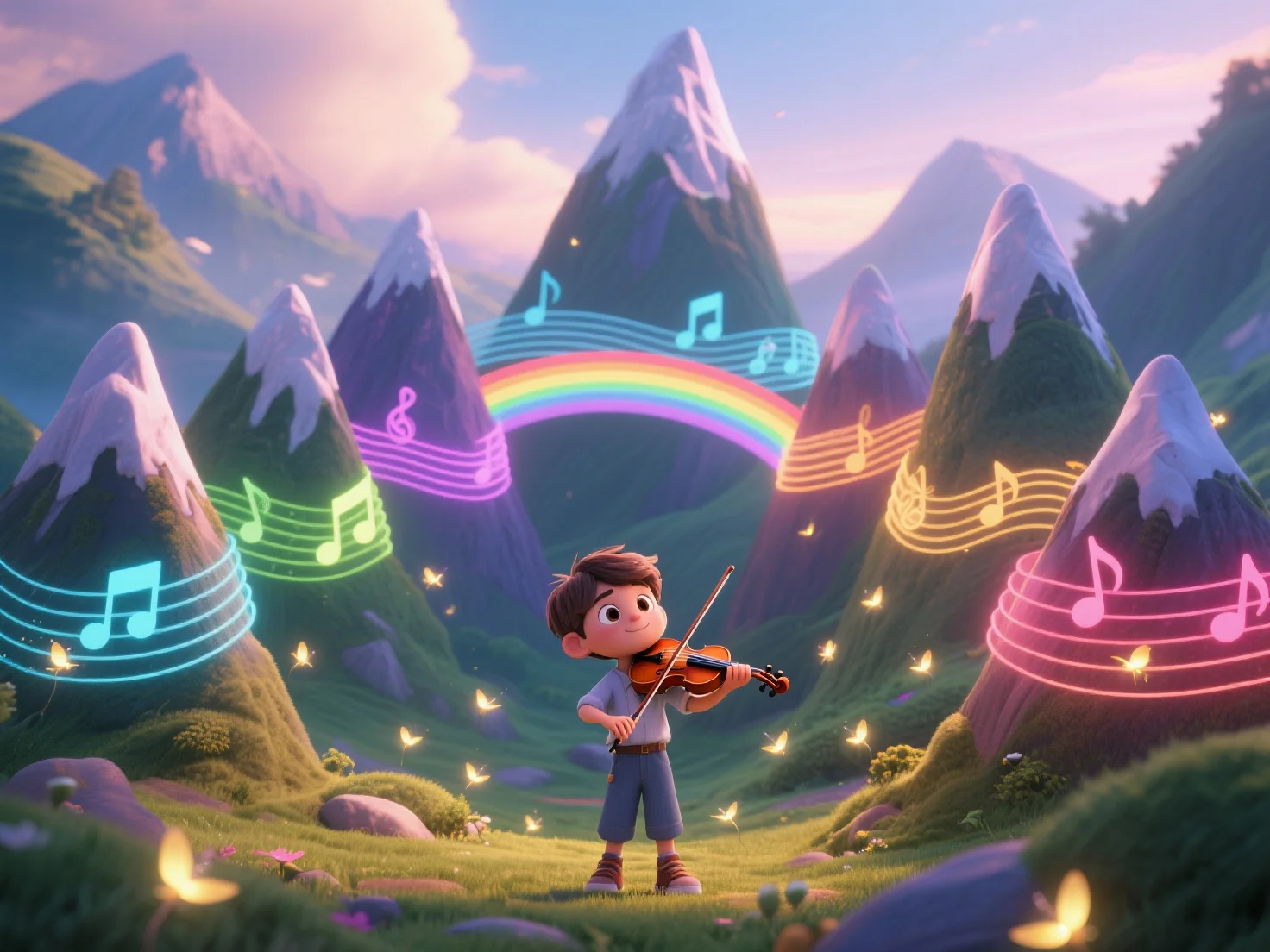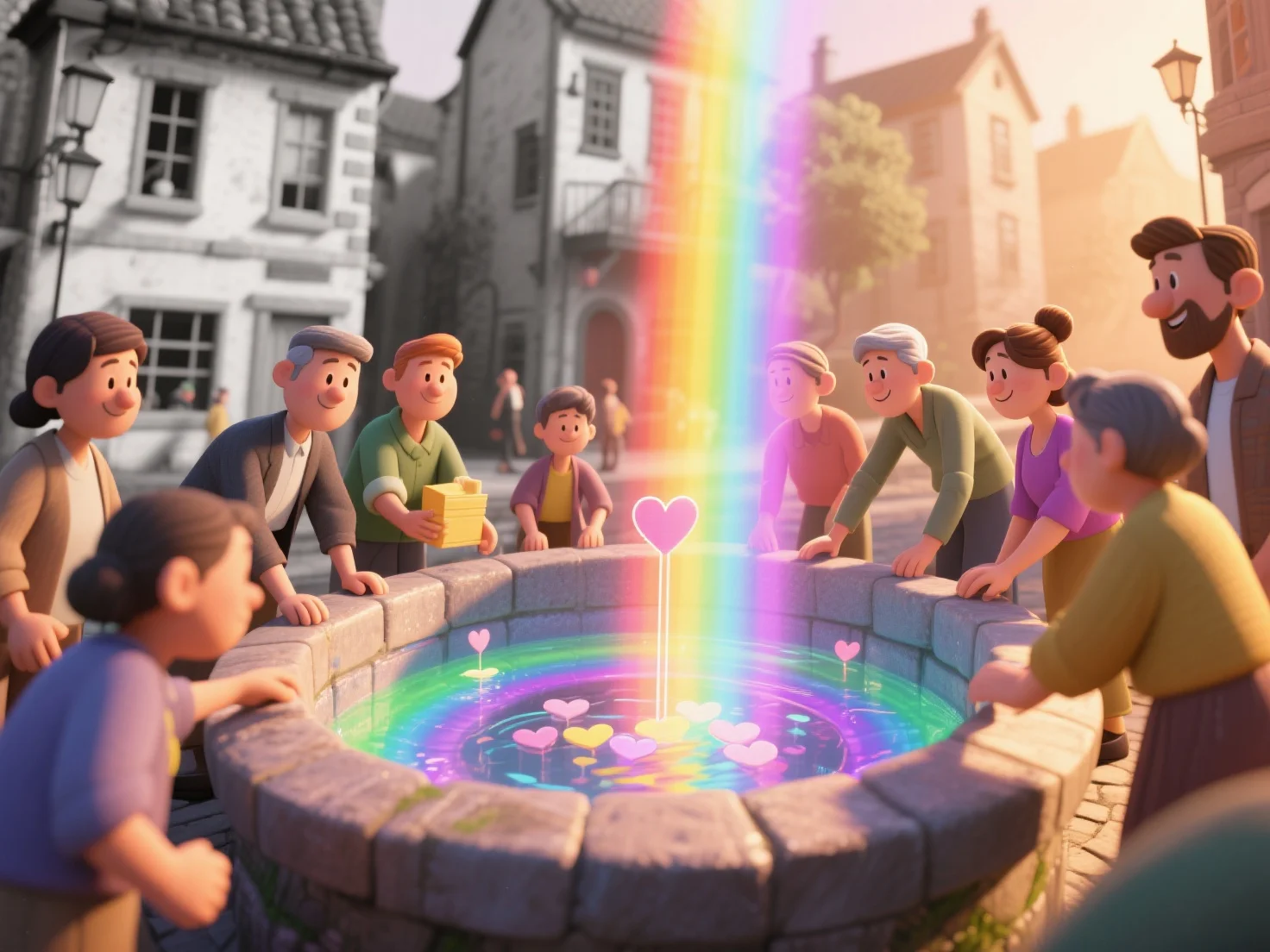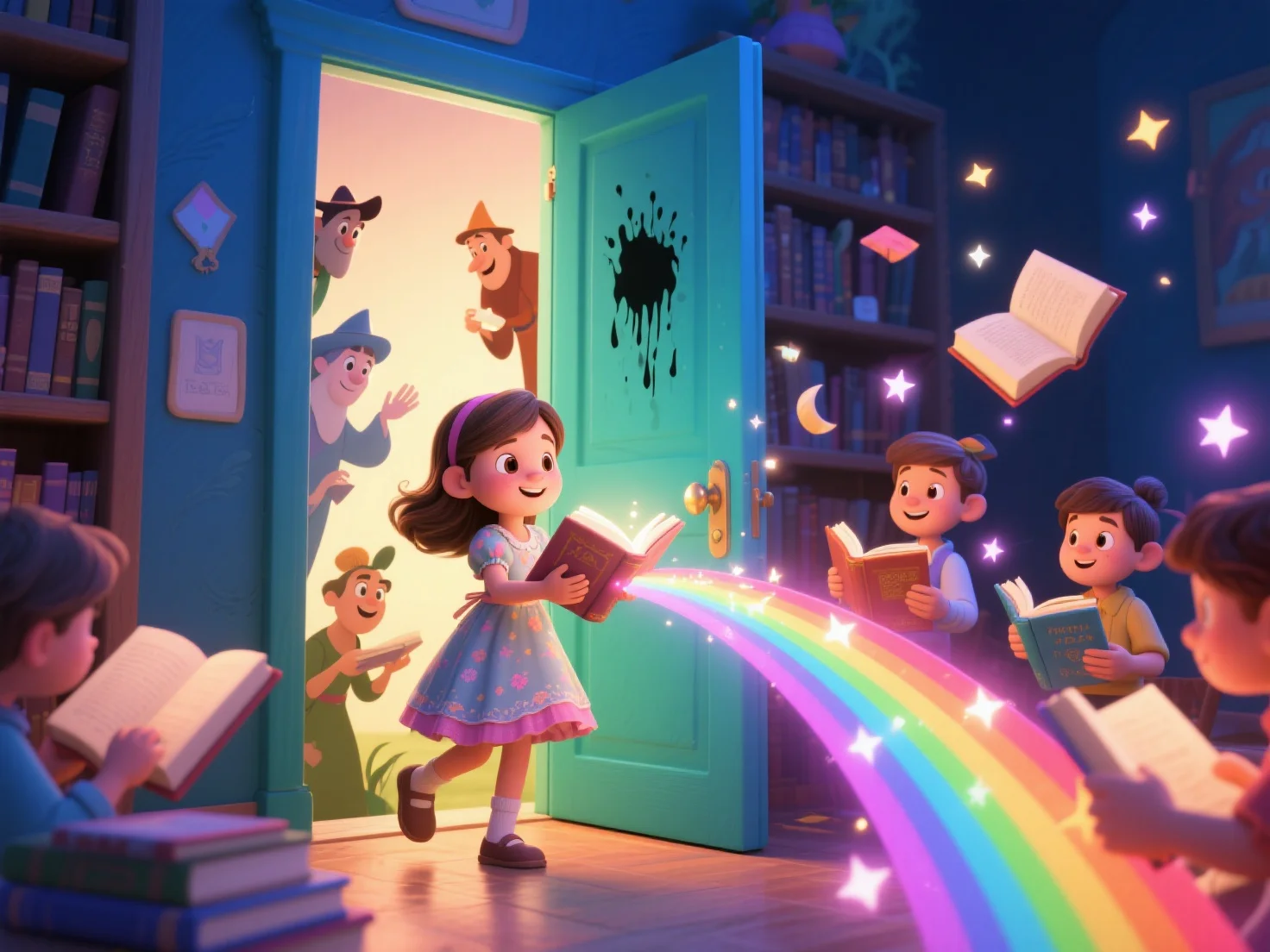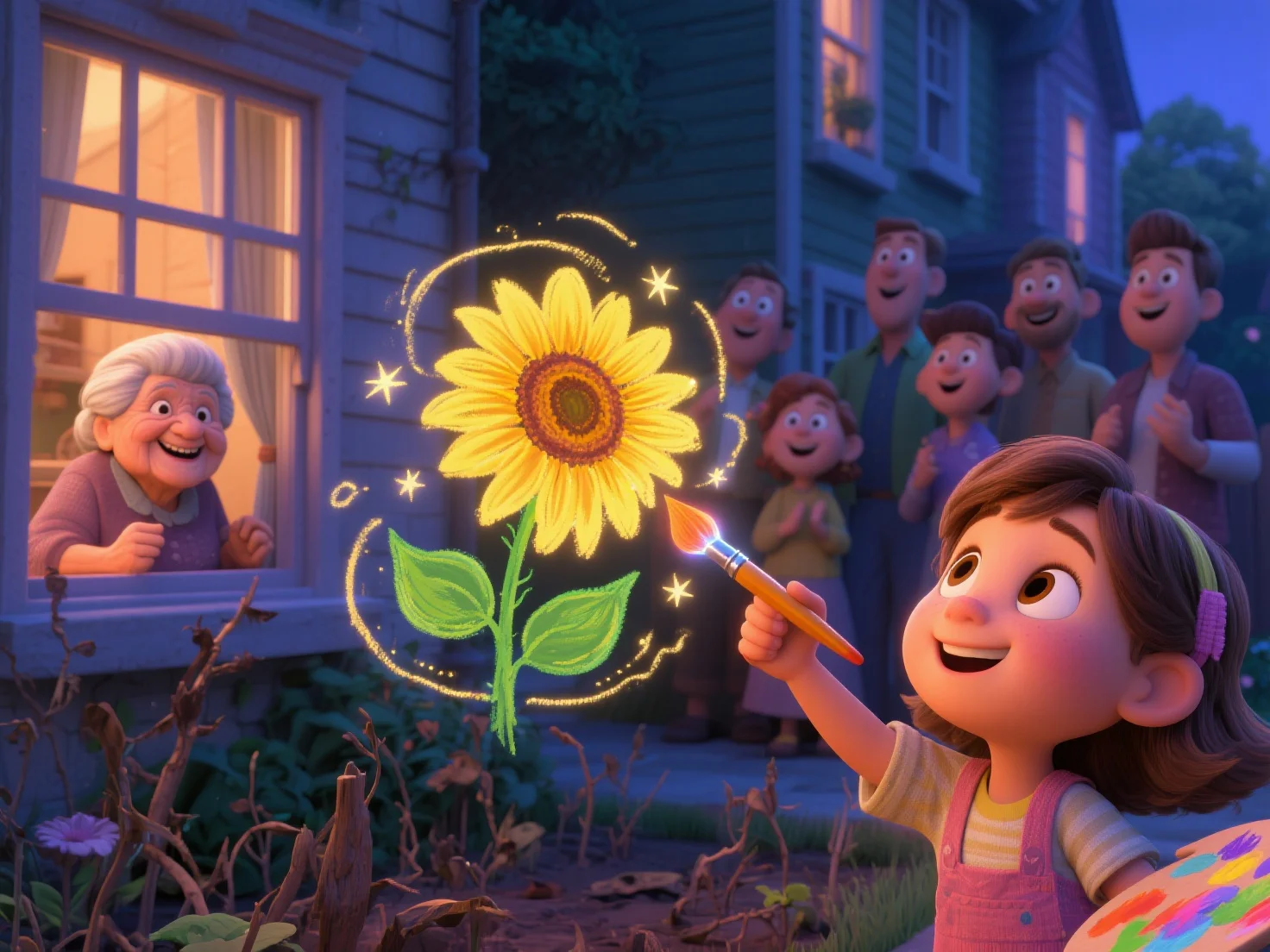The Mountains That Sing Together
A magical tale about Melody, a young girl who discovers that the mountains around her village can sing, and how music brings communities together.

The Mountains That Sing Together
High in a valley surrounded by seven magnificent mountains, there lived a little girl named Melody who had the most extraordinary gift—she could hear music in everything around her. The wind through the trees played like flutes, the babbling brook sang like a soprano, and even the chirping birds seemed to harmonize in perfect orchestral arrangements.
But Melody's favorite sounds came from something that most people couldn't hear at all: the mountains themselves.
Every morning as the sun rose, Melody would sit on the wooden steps of her family's cottage and listen carefully. If she concentrated just right, she could hear the mountains humming—deep, resonant notes that seemed to come from the very heart of the earth.
"Do you hear that, Grandpa" she would ask her grandfather, who lived with Melody and her parents.
Grandpa would pause from feeding the chickens and listen carefully. "All I hear are the usual mountain sounds, dear one. What do you hear"
"The mountains are singing," Melody would say with absolute certainty. "Each one has its own voice."
The Seven Mountain Voices
Over many weeks of careful listening, Melody began to distinguish the different voices of each mountain:
Mount Harmony (the tallest peak) had a deep bass voice that rumbled like distant thunder.
Melody Ridge (named after her, according to the villagers) sang in a rich baritone that reminded her of her father's voice when he sang lullabies.
Echo Peak had a tenor voice that seemed to bounce and dance through the air.
Crystal Mountain sang in a clear alto, like the sound of wind chimes made of pure glass.
Sunrise Summit had a bright soprano voice that seemed to sparkle with the first rays of dawn.
Whispering Heights sang in a soft mezzo-soprano, gentle and comforting like her mother's humming.
Sunset Crown had a dramatic soprano voice that painted the sky with musical colors each evening.
But here was the strange thing—while each mountain had its own beautiful voice, they never seemed to sing together. Each one sang its own song at different times, creating a lovely but disconnected series of solo performances.
"I wish they would sing together," Melody told her grandmother one evening. "Imagine how beautiful it would sound if all seven mountains harmonized!"
Her grandmother, who was wise in the old ways, smiled knowingly. "Some things, dear child, need a conductor to bring them together."
The Village's Problem
Melody lived in the village of Harmonydale, which had always been known for its peaceful, music-loving community. But lately, the village had been facing some challenges.
The annual Harvest Festival was coming up—a celebration where all the surrounding villages came together to share food, music, and friendship. But this year, Harmonydale was struggling.
The village choir had broken up after a disagreement about what songs to perform. The folk dancers couldn't agree on which traditional dances to showcase. Even the children's music group had disbanded because they couldn't decide on an instrument arrangement.
"It seems like everyone in our village has forgotten how to work together," Melody's mother said sadly during dinner one night. "The festival is only two weeks away, and we don't have any performances prepared."
"Maybe we should just skip the festival this year," suggested Melody's father. "It's embarrassing to go with nothing to contribute."
But Melody had an idea—one that involved the singing mountains.
The Mountain Conductor
The next morning, Melody packed a small knapsack with water and sandwiches and set off up the mountain trails. She had decided to visit each mountain and see if she could somehow encourage them to sing together.
Her first stop was Mount Harmony, the tallest peak. The climb was steep, but Melody was determined. When she reached a high plateau where she could feel close to the mountain's spirit, she sat down and listened.
Sure enough, the deep bass humming began. It was a beautiful, resonant sound that seemed to make the rocks themselves vibrate with music.
"Mount Harmony," Melody said aloud, feeling a bit silly but determined to try, "your voice is magnificent. But I think it would be even more beautiful if you sang with your neighbors."
The humming paused for a moment, then resumed—but now it seemed more thoughtful, as if the mountain was considering her words.
The Musical Mission
Over the next several days, Melody visited each of the seven mountains. To Melody Ridge, she explained how wonderful it would be if the baritone voice joined with Mount Harmony's bass. To Echo Peak, she described how the tenor voice could weave between the lower voices. To Crystal Mountain, she painted a picture of how the alto voice could bridge the gap between low and high notes.
With each visit, Melody noticed something interesting. The mountains began to sing more frequently, and sometimes their songs would overlap slightly, as if they were trying to find ways to harmonize.
But still, they weren't quite singing together.
The Village Rehearsal
Meanwhile, inspired by Melody's dedication to bringing the mountains together, something interesting began happening in the village.
Mrs. Chen, who had been the choir director before the group disbanded, overheard Melody telling her grandmother about the mountain voices. "You know," Mrs. Chen said thoughtfully, "if a little girl can try to get seven mountains to sing together, maybe we adults can figure out how to work together too."
She reached out to the other choir members and suggested they meet to discuss their differences. "Let's focus on what we all love about music instead of what we disagree about."
The folk dancers heard about the choir getting back together and decided to do the same. "Maybe we can create a dance that incorporates moves from different traditions," suggested Mr. Petrov, the dance group leader.

Even the children's music group began meeting again. "What if we let each child choose their favorite instrument, and then we find songs that showcase everyone" proposed Ms. Rodriguez, their teacher.
The Mountain Concert
One week before the Harvest Festival, Melody had visited all seven mountains multiple times. She had sung to them, talked to them, and even tried conducting imaginary orchestras while standing on their slopes.
That evening, as the sun was setting, Melody sat on her cottage steps feeling a bit discouraged. She had been so sure she could get the mountains to sing together, but despite all her efforts, they still sang separately.
But then, just as the first stars appeared, something magical happened.
It started with Mount Harmony's deep bass note, rumbling across the valley. Then Melody Ridge joined in with its baritone harmony. Echo Peak added its tenor voice, bouncing playfully between the peaks. Crystal Mountain's alto voice rang clear and true, while Sunrise Summit's soprano sparkled even in the darkness.
Whispering Heights added its gentle mezzo-soprano, and finally, Sunset Crown's dramatic soprano soared above all the others, painting the night sky with musical starlight.
For the first time ever, all seven mountains were singing together in perfect harmony.
The sound was absolutely breathtaking—a chord so rich and full that it seemed to make the entire valley resonate with beauty. Animals stopped to listen, night birds joined in with their own melodies, and even the wind seemed to adjust its rhythm to match the mountain symphony.
"Grandpa! Grandma! Mom! Dad! Come quickly!" Melody called to her family.
They all rushed outside, and while they couldn't hear the mountain voices the way Melody could, they could feel something extraordinary in the air—a sense of harmony and rightness that made their hearts feel full.
"I can't hear exactly what you hear, dear one," said her grandfather, "but I can feel that something beautiful is happening."
The Festival Preparation
The next day, word spread throughout the village about the magical evening. Even people who hadn't believed in Melody's mountain singing stories admitted that something special had occurred.
"If Melody could bring seven mountains together in harmony," said Mrs. Chen, "then we can certainly bring our little village together for the festival."
The choir members agreed to perform a medley that included everyone's favorite songs. The dancers created a performance that wove together moves from different cultural traditions. The children's music group arranged pieces that highlighted each child's chosen instrument while creating beautiful ensemble moments.
But most importantly, they decided to dedicate their entire festival contribution to Melody and her mountain symphony.
The Harvest Festival
The day of the Harvest Festival arrived with perfect weather and excitement in the air. Villages from all around the region had come together to celebrate, share food, and enjoy each other's performances.
When it was Harmonydale's turn to perform, the entire village took the stage together—something that had never happened before.
Mrs. Chen stepped forward as the announcer. "This year, our village learned an important lesson about harmony from a very special young girl and seven singing mountains. We'd like to dedicate our performance to the idea that when different voices come together, they create something more beautiful than any solo could ever be."
The choir began singing, their voices blending beautifully. The dancers moved in perfect synchronization, their varied styles creating a rich tapestry of movement. The children's orchestra played with enthusiasm, each instrument contributing to a joyful, complex melody.
But the most magical moment came when Melody, standing at the center of it all, began to conduct—not just the village performers, but somehow, in that moment, the mountains themselves.
As the village performed, those who knew how to listen could hear the seven mountains humming along, their deep harmonic foundation supporting and enhancing every note the humans sang.
The Harmony Lesson
After the festival, people from other villages approached Melody with curiosity and wonder.
"How did you learn to hear the mountains sing" asked a little boy from the neighboring valley.
"I think," Melody said thoughtfully, "that the mountains were always singing. I just learned how to listen. And once I understood that each one had its own voice, I wanted to help them find a way to sing together."
"But how did you get them to harmonize" asked the boy's mother.
Melody thought about this carefully. "I think they wanted to sing together all along, but they needed someone to believe it was possible. Once I showed them that I believed in their music, they found their own way to harmony."
An elderly woman from a distant village nodded wisely. "And your village learned the same lesson, didn't they Sometimes people need someone to believe in their ability to work together before they can find their harmony."
The Continuing Symphony
From that day forward, the seven mountains continued to sing together every evening at sunset. Melody would sit on her cottage steps and conduct their symphony, and gradually, other children in the village began to hear the mountain voices too.
The village of Harmonydale became known throughout the region not just for its beautiful location, but for its harmonious community spirit. People would come from far away to learn about how the village had overcome its differences and learned to work together.
Melody grew up to become a music teacher and conductor, but she never forgot the lesson of the singing mountains. She taught her students that the most beautiful music happens when different voices find ways to support and enhance each other rather than competing or trying to sing alone.
The Mountain Music School
Years later, Melody founded the Mountain Harmony School right there in the valley, where children from all the surrounding villages could come to learn about music, cooperation, and the art of listening to the world around them.
The school's motto, carved in stone at the entrance, read: "Every voice matters, every voice is beautiful, and together we create something greater than the sum of our parts."
Students at the school learned traditional music theory and instruments, but they also learned to listen to the music in nature—wind songs, water rhythms, bird symphonies, and yes, mountain harmonies.
And every evening at sunset, the students would gather in the school's outdoor amphitheater and listen as Melody conducted the seven mountains in their nightly concert, learning that harmony—both musical and social—requires patience, respect, and the willingness to blend your voice with others while still maintaining your unique contribution to the song.
The End
Remember: The most beautiful music—and the most harmonious communities—happen when everyone contributes their unique voice while working together toward a common goal. Sometimes all it takes is one person who believes in the possibility of harmony to help everyone else find their way to sing together.
Recommended Stories
Discover more amazing stories and continue your reading journey ✨



